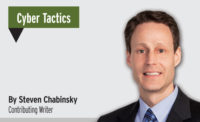The cyber intrusion headlines may focus on the Fortune 100 being hacked, but they’re not the only victims. Not by a long shot. Naturally, since 99.9 percent of all U.S. businesses have fewer than 500 employees, and few of those retain dedicated information security staff, cyber criminals find small and medium enterprises to be attractive targets. Surprising to many, however, is that foreign intelligence services also are interested in SMEs. After all, they produce 16.5 percent times more patents per employee than large patenting firms, and are far more likely to develop emerging technologies than large firms. Making matters worse, targeted attacks against SMEs appear to be increasing dramatically. Perhaps this is because, as third-party vendors, SMEs also tend to be softer targets than the larger businesses they serve. The facts bear out this hypothesis. Smaller businesses are significantly more likely to be running spyware and keystroke loggers than large companies. They also are getting hacked twice as often through brute force attacks, reflecting that SMEs are more likely to permit the use of default user credentials, easily guessable credentials, or weak credentials that cannot withstand the onslaught of an automated dictionary attack.
The good news is that SMEs can significantly reduce their cyber risk against the greatest potential harms even without a large IT budget. The first step is, and always will be, to prioritize what truly needs to be protected. Consider engaging your managers in worst-case-scenario planning. Explore real-world events that, if they happened to your business, would compromise confidentiality, integrity and/or availability of (1) your information systems, especially keeping in mind those with unique or hard-to-recreate functions such as proprietary software applications or industrial capabilities; or, (2) the information processed, stored and transmitted on your network. Would the event cause your operations, assets, or people to suffer limited, serious, or severe harm? By first evaluating the impact of a compromise without dismissing low-likelihood scenarios, you will ensure that your team remains on heightened alert to protect those specific assets should the nature of the threat increase over time. It is at this point, having identified your greatest potential losses, that you should prioritize your risks by factoring in their probability.
Armed with your cyber security priorities, consider next how you might enhance their protection. The National Institute of Standards and Technology recommends a veritable laundry list of considerations to lower cyber risk, covering 17 different areas. The easiest way to approach so many possible controls may be to start by isolating your most critical systems and data. For example, about four years ago SMEs were facing a rash of high-value losses due to fraudulent Automated Clearing House transactions (a fancy term for online banking). Even companies that were using hardware-based two-factor authentication to log in to their banks were part of a growing list of victims that, combined, lost hundreds of millions of dollars. Some went bankrupt, and the problem gained media attention. How was the problem solved? Easily. Commercial banking customers were advised to carry out their online banking activities from an isolated stand-alone computer. The trick was to have the cultural discipline to prohibit – from that one machine – all e-mail and Web browsing, those being the most likely paths for malware infection. The results? Remarkable. I was told that those who followed the advice never fell victim to this massive fraud. All for a security price tag less than $1,000.
The concept of isolation plays out as well for critical data and services that must be shared. Consider consolidating and monitoring the path from, and the “escape route” to, the Internet. Numerous logs should all be stored in a protected centralized system that is time synchronized and easily searchable. But the first step is to ensure they are simply turned on, which will allow an incident response team or law enforcement to step in and more quickly identify, isolate and remediate the source of a breach. The Federal government implemented this process under its Trusted Internet Connection (“TIC”) initiative, which likely “TIC-ked” off a lot of would-be hackers. Simply put, the fewer egress points to monitor, the better it is to focus your resources and detect malicious activity. When you visit a hospital nursery, there is only one door in and out, it is locked and there are cameras. There’s a reason for that; it works.
Finally, big cyber security wins across SMEs can be achieved by focusing on account monitoring and controls (restricting Administrator privileges, requiring strong passwords, monitoring and deactivating accounts), deploying end-to-end encryption solutions (data may be stolen, but it can’t be used), patching and updating operating systems and third-party applications (enable auto-updating features) and adopting meaningful back-up strategies (preferably off-site and either offline or on write-once media for the most critical data).
There may be no getting around the fact that the average SME outspends larger companies on IT security per employee and as a percentage of revenue. Still, IT efficiency is improving, allowing SMEs to get more value for their security dollar. And, in terms of emerging technology, there is no doubt that SMEs are and will continue to be at the forefront of developing highly anticipated, game-changing cyber security solutions.
About the Author:
Steven Chabinsky is Chief Risk Officer and Senior Vice President of Legal Affairs for the cyber security technology firm CrowdStrike, where he advises the company and its clients on CrowdStrike’s incident response services, cyber intelligence products, and intrusion detection and attribution platform. He previously served as Deputy Assistant Director of the FBI’s Cyber Division.



